Summer’s in full swing and it’s hot outside – damn hot. Why risk getting sunburn or skin cancer when you can stay inside where it’s cool? And with all these Genesis games to play, there’s more than enough to keep you occupied until the weather lets up.
After Burner Complete By Ken Horowitz
 I consider the version of After Burner on the Saturn Sega Ages collection to be the definitive one to play. With the Mission Stick, it’s about as arcade as you can get at home (unless people stand on either side of you and rock your chair from side to side). Along with OutRun and Space Harrier, it completes the holy trinity of great Sega ports that actually have a true arcade feel.
I consider the version of After Burner on the Saturn Sega Ages collection to be the definitive one to play. With the Mission Stick, it’s about as arcade as you can get at home (unless people stand on either side of you and rock your chair from side to side). Along with OutRun and Space Harrier, it completes the holy trinity of great Sega ports that actually have a true arcade feel.
In the 16-bit realm though, the 32X version of After Burner reigns supreme. I’ve yet to play it with a true joystick only because I haven’t found one that convinces me, but even with a controller it’s sheer joy to play. The presentation and sense of speed are all there, and the gameplay is tight and responsive, just the way After Burner is supposed to be.
I’ve heard people criticize both After Burner Complete and Space Harrier because they were mere arcade ports without any frills. Frankly, I would have been quite content if the 32X had gone this route and produced arcade-perfect renditions of Galaxy Force, Power Drift, or other classic Sega arcade titles. You can’t go wrong with classic, arcade Sega!
Castle of Illusion Starring Mickey Mouse By Sebastian Sponsel
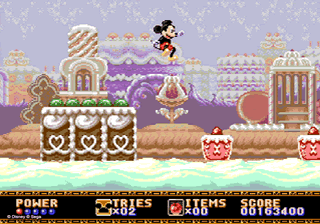 Recently, I had a strange but sudden realization: I had never actually played Castle of Illusion to the very end! The strange part of this insight was that this was one of the first ten or so Genesis games I ever had, and one of only two that I’ve owned as a physical copy for over twenty years (for those of you that are interested, the other one is Klax, for some reason). I always liked the game, but as a kid, I only managed to beat it in practice mode. On harder difficulty, my final destination was always the level three boss, with his mirage attack. Only owning the game in Japanese also played its part in why I never really got around to actually finishing it proper.
Recently, I had a strange but sudden realization: I had never actually played Castle of Illusion to the very end! The strange part of this insight was that this was one of the first ten or so Genesis games I ever had, and one of only two that I’ve owned as a physical copy for over twenty years (for those of you that are interested, the other one is Klax, for some reason). I always liked the game, but as a kid, I only managed to beat it in practice mode. On harder difficulty, my final destination was always the level three boss, with his mirage attack. Only owning the game in Japanese also played its part in why I never really got around to actually finishing it proper.
It was an interesting experience to revisit Castle of Illusion after more than two decades. Even after all those years, I’m still amazed at how well this game plays. The controls are great, the graphics are almost incredibly good for such a relatively early Genesis game, and even long after playing I still find myself whistling the theme to the first stage. Though I’m still getting pissed about stages two and three of the third level, with all of these leaps of faith and carefully timed pinpoint jumps you have to do. Guess that’s why I never mustered the patience of actually finishing the game when I was a little ten-year-old twerp. Also, the level three boss is actually pretty easy if you actually manage to bring a few marbles to shoot at him to the fight.
Funny… when I was a kid, I always thought the boss was a strange insect-like thing. Now I realize it’s some kind of frog instead. Weird how memory and perception can play tricks on you like that.
Squirrel King By Greg Jurkiewicz
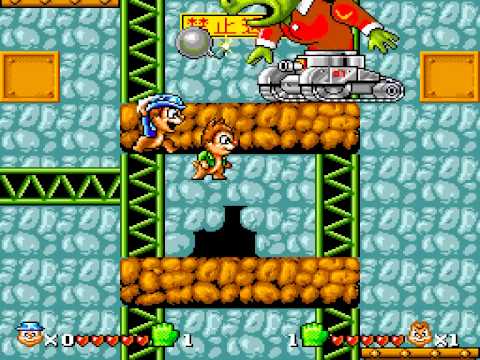 Recently I picked up a box of unlicensed Chinese pirate games, some Argentinian bootlegs and some other random oddities, as I generally find such things interesting. I’ve been on the hunt for a cart copy of Squirrel King for quite some time, so it was very satisfying to finally have it in my possession. It came in a really crappy cart shell with an even crappier, poorly applied label that had a picture of Conker (from Conker’s Quest). The hilarious thing is he’s a squirrel, and the game Squirrel King, bewilderingly enough, doesn’t actually feature any squirrels. For those that don’t know, it’s a pirate game featuring unlicensed likenesses of Disney’s Chip and Dale (they’re chipmunks), and no, none of the enemies are squirrels either… So where the name Squirrel King comes from is really a mystery. Perhaps in Taiwan they don’t differentiate between the two animals. Anyway, the game is loads of fun, and can compete with many official releases on the system. You can read what I had to say about the gameplay specifics here.
Recently I picked up a box of unlicensed Chinese pirate games, some Argentinian bootlegs and some other random oddities, as I generally find such things interesting. I’ve been on the hunt for a cart copy of Squirrel King for quite some time, so it was very satisfying to finally have it in my possession. It came in a really crappy cart shell with an even crappier, poorly applied label that had a picture of Conker (from Conker’s Quest). The hilarious thing is he’s a squirrel, and the game Squirrel King, bewilderingly enough, doesn’t actually feature any squirrels. For those that don’t know, it’s a pirate game featuring unlicensed likenesses of Disney’s Chip and Dale (they’re chipmunks), and no, none of the enemies are squirrels either… So where the name Squirrel King comes from is really a mystery. Perhaps in Taiwan they don’t differentiate between the two animals. Anyway, the game is loads of fun, and can compete with many official releases on the system. You can read what I had to say about the gameplay specifics here.
Needless to say I had fun playing it through on real hardware. Squirrel King is fairly easy until you get to the Toxic Nucleon Dump level and it turns into level memorization and button reflex hell. Once you beat that though, the game takes it easy on you as a reward. It was very satisfying to beat it without save states, though to be fair since just about everything in this game gives you lives the only real limiting factor in whether you beat it or not is your patience.
The other bit of fun I had with it was taking the PCB out of the cheap cart shell and putting it into a nicely cleaned up official cartridge with my own custom label on it. I have no bad feelings about sacrificing a $0.50 copy of NFL ’94 to salvage the cart shell and put an actually good game in there. Curiously enough, NFL ’94 has possibly the highest quality cart shells too, so the final product looks especially good when it’s done. Call me weird, but I find the whole process of refurbishing these games almost as much fun as playing them.
Galaxy Force II By goldenband
I’m not sure why Galaxy Force II piqued my curiosity, but despite the game’s poor reviews, I found myself intrigued enough to add it to my want list of Genesis games. In January of this year I managed to score a complete copy for only a couple of bucks, and when it arrived in the mail I was excited to check it out. When I popped the game in, however, I was completely repulsed: “What’s going on? Why is my main gun so useless? How am I taking these hits? Wait, now the game’s yelling at me to turn…I’m crashing into everything!…I’m out of energy? Game over? Forget this!”
And so it sat on my shelf for six months, ignored, a testament to a misguided purchase.
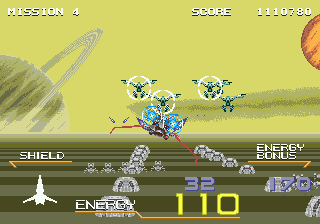 But recently a user on YouTube posted a video listing what are allegedly the 20 worst games for the Genesis, with Galaxy Force II in at #19. That spawned a discussion on Sega-16, and before I knew it my curiosity was piqued again, perhaps because I’m somewhat in the habit of taking on and beating games with bad reputations. After all, I’ve mastered Sword of Sodan, tripped my way through Dark Castle, and gritted my teeth through Fantasia, so how bad could it really be?
But recently a user on YouTube posted a video listing what are allegedly the 20 worst games for the Genesis, with Galaxy Force II in at #19. That spawned a discussion on Sega-16, and before I knew it my curiosity was piqued again, perhaps because I’m somewhat in the habit of taking on and beating games with bad reputations. After all, I’ve mastered Sword of Sodan, tripped my way through Dark Castle, and gritted my teeth through Fantasia, so how bad could it really be?
Well, I ended up spending some time with Galaxy Force II over the weekend, and to my surprise, I liked it quite a bit. I should add the disclaimer that I have no experience with the arcade game, and I don’t doubt that as a port, it’s pretty mangled…
…but as a standalone game for the Genesis, I think it’s not bad at all. Sure, it’s got flicker, sprite breakup, and a few other issues besides, yet somehow it’s still fun and engaging. The quality soundtrack certainly doesn’t hurt either — especially the excellent level one tune, an odd-meter jazz-rock jam in classic early 16-bit style (and which, in a nice touch, comes back at the very end of the game).
Even though Galaxy Force II is so short, only taking about 15 minutes to complete, I didn’t mind at all and even looked forward to replaying it — enough so that I finished it five times during the weekend, starting with easy settings and working my way up. Once you get to the highest difficulty settings, the game gets very tough to beat indeed! It reminds me oddly of Marble Madness, in that it’s essentially a time-based game and a skilled player can usually make it to the last stage…but all your previous mistakes will catch up to you there.
I won’t claim Galaxy Force II is a great game, and I was very put off when I first played it. But in the end, I got a lot more enjoyment from Galaxy Force II than its reviews – and my own first impressions – led me to expect.
Monster World IV By Frank Ramirez
As soon as I heard that Sega was releasing the Monster World Collection for the XBLA, of COURSE I was excited. I love Wonder Boy in Monster World (also my first reader roundtable submission), and I really enjoyed Wonder Boy in Monster Land on the Master System (via Wii Virtual Console), but I never did get around to playing Monster World IV. I had already downloaded the translated ROM, but for whatever reason, I just didn’t boot it up. I opted for the XBLA version because it was just a much better deal, and I could map the buttons however I saw fit.
For me, Monster World IV’s reputation had preceded it. I’d read the reviews and a Stories from the Book of Genesis entry, relating the interesting story of one member’s endeavors for securing a copy of this game and a Mega Key to play on their US Genesis, as well as YouTube videos from such personalities as Happy Console Gamer and the Game Sack duo. I mean what wasn’t there to like about this game? Great music, really pretty graphics that must have pushed the Mega Drive further than even IT thought it could; needless to say, as I was all set to download the collection, my expectations were pretty high. I was expecting nothing short of greatness here.
And greatness is what I got.
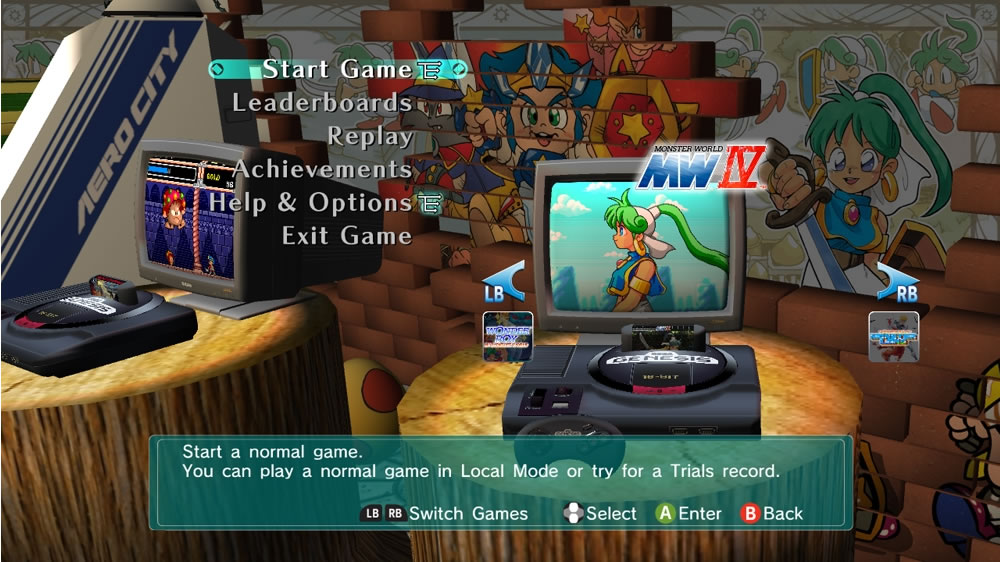 The controls were fantastic, and the gameplay was thankfully faster than Wonder Boy in Monster World’s. Cute little Asha could cavort about at pretty high speeds, taking out monsters left and right. Ah yes, the “c” word. Monster World IV’s aesthetic can be described as “cute” very easily. Asha herself exudes a lot of cuteness, from her walking animation, to opening a chest, to keeping her balance on a treadmill platform, to skidding on her bum across an icy surface. I especially loved how she interacted with Pepe, her blue Pepelogoo companion. And the way the game world slowly changed was subtle, the further you progressed into games, as the townsfolks’ attitudes became darker and murkier, and the Queen became… bitchy, for lack of a better word.
The controls were fantastic, and the gameplay was thankfully faster than Wonder Boy in Monster World’s. Cute little Asha could cavort about at pretty high speeds, taking out monsters left and right. Ah yes, the “c” word. Monster World IV’s aesthetic can be described as “cute” very easily. Asha herself exudes a lot of cuteness, from her walking animation, to opening a chest, to keeping her balance on a treadmill platform, to skidding on her bum across an icy surface. I especially loved how she interacted with Pepe, her blue Pepelogoo companion. And the way the game world slowly changed was subtle, the further you progressed into games, as the townsfolks’ attitudes became darker and murkier, and the Queen became… bitchy, for lack of a better word.
The music is quite excellent as well. The main theme of the game shows up in different arrangements here and there, and it’s now permanently etched in my brain. I think my favorite tune is when you summon the Genie of the lamp. I get a real kick out of his lazily sarcastic theme music. It’s all of these little things in the graphics and the music put together that gives this game that extra charm.
One thing I really commend this game for is definitely the artistic style. The Arabian setting is pretty original, and not used very much, aside from the Prince of Persia games. The turbaned guards with their scimitars, the genie in the lamp, and flying magic carpets, all of the things you’d expect are there. I really liked getting to have a good look at Shion’s helpers from the previous game after the major boss battles. They deserve some spotlight. And the COLORS! The designers really made the best of the Mega Drive’s admittedly limited color palette. Bold colors and dreamlike pastels were put to very excellent use in the levels.
I think the only quibble I have about this game, and it’s a VERY minor one… actually it’s just a nitpick. “Purapril” was rendered as “Prapril” in the opening narration, but then again, I suppose it’s a little unrealistic to expect a 100% consistent translation when the last game was done over 15 years ago. Oh well.
As of 7/25, I have beaten this game. Unfortunately, I missed out on 12 Life Drops, so no achievement for me. I guess that means I get to do another playthrough.
Awesome.
Raiden Trad By The Coop
Shmups. The Genesis had it’s fair share to be sure, and it was a roller coaster in terms of quality. From the highs of games like Thunder Force IV and M.U.S.H.A., the lows of The Earth Defend and XDR X-Dazedly-Ray, and the WTFs of Divine Sealing, the Genesis covered it all. However, buried in amongst all these U.S. and Japanese shmups, was one game that came in a garish hot pink and lime green box; one that got a lot of flack as a port, but that I personally always enjoyed. I’m speaking of course, of Raiden Trad.
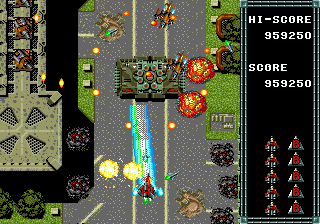 A port of the arcade game, Raiden by Seibu Kaihatsu, it’s been shot down for questionable music, dull colors, a lack of animation, minimal bullet count, and not having loops like the arcade game did. Well, some of that’s true. There are missing animations, some short cuts were taken with the rotation of the ships, and the colors don’t exactly jump off at the screen at you. But you know what? It still feels like Raiden. I kind of like the more laid back feel of the Genesis music, and the fact that they gave the game an ending is a good thing to me (sorry folks, but I’m not fond of looping shmups). Turn up the difficulty, and there are plenty of bullets moving at a fast clip, and there’s even an extra stage at the end with the difficulty level cranked way, WAY up. The bigger explosions have a good THUD to them, and overall, I just think that this port gets a bad rep for being horrid when to me, it’s not. It isn’t arcade perfect, but it is a faithful translation that has the core of the original game, despite the cuts here and there.
A port of the arcade game, Raiden by Seibu Kaihatsu, it’s been shot down for questionable music, dull colors, a lack of animation, minimal bullet count, and not having loops like the arcade game did. Well, some of that’s true. There are missing animations, some short cuts were taken with the rotation of the ships, and the colors don’t exactly jump off at the screen at you. But you know what? It still feels like Raiden. I kind of like the more laid back feel of the Genesis music, and the fact that they gave the game an ending is a good thing to me (sorry folks, but I’m not fond of looping shmups). Turn up the difficulty, and there are plenty of bullets moving at a fast clip, and there’s even an extra stage at the end with the difficulty level cranked way, WAY up. The bigger explosions have a good THUD to them, and overall, I just think that this port gets a bad rep for being horrid when to me, it’s not. It isn’t arcade perfect, but it is a faithful translation that has the core of the original game, despite the cuts here and there.
So yeah, I know some find the TG-16 version better, some like the Jaguar version more, and some even prefer the botched SNES version to the Genesis one. Other than the SNES game, other ports have various strengths over the take that came to Sega’s 16-bit system. But you know, I like the Genesis port of the arcade classic. It’s got some issues, but it still looks all right, sounds pretty nice, and plays well. It didn’t lose the spirit and feel of the arcade original, and overall, I think it turned out better than a fair number of people give it credit for.
Samurai Shodown (Sega CD) by Frank Villone
Samurai Shodown has always seemed elusive and mysterious. As a kid, I briefly glimpsed the arcade machine, someplace obscure. (Probably one of those strange, small arcades inside of a log cabin, at a family campground somewhere!) Instantly I was impressed by the swords, the screen zooming in and out, and the traditional Japanese themes in the art and music! I never got to play it, as I was saving my few quarters for something else (probably Street Fighter II). Like the legendary Neo Geo itself, Samurai Shodown became a faint dream of something awesome, that I hoped to play someday. A couple decades later, I bought a PlayStation 2 Slim (mainly to use as a DVD player), eventually got a couple of PS2 collections with Samurai Shodown, and the original is just as great as I had always expected! (Although I later learned that these particular collections are poorly-emulated.) I got the Sega CD game after those for the PS2, so it never got much attention, until recently when I picked up the Genesis version, to compare it!
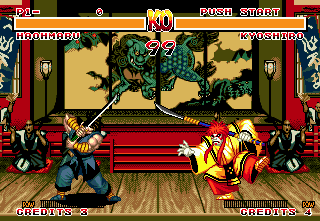 As Haohmaru is my fighter of choice, I was shocked to find that the Genesis cart lacks his normal strong slash animation! On Sega CD, the full arcade move-set is present, and it feels great to properly slash opponents from across the screen! The CD audio of the original soundtrack, greatly helps it resemble the Neo Geo experience! Gameplay and graphics are impressively close to the original on both Genesis and Sega CD – minus the zooming, and a few colors – but on CD it looks best, with the largest characters, smoothest animation, best use of color, and a few better backgrounds (especially for Hanzo, Gen-an, and Wan-fu). The Genesis version does have a few things that are missing on CD: The referee, the announcements before and after a round, and the interaction with the backgrounds (like cutting down bamboo in the forest)! While these are missed on CD, they are far outweighed by the mentioned soundtrack and full move-set, plus other things, like the opening sequence, and the announcement of both characters’ full names before each match! While it does not live up to its full potential (as it could have been much more complete), this is still the best 16-bit version of Samurai Shodown, slicing through the Genesis game! The horrible SNES game is barely worth mentioning, other than remarking on how ugly it is, with characters that are way too small, and who bleed orange blood!
As Haohmaru is my fighter of choice, I was shocked to find that the Genesis cart lacks his normal strong slash animation! On Sega CD, the full arcade move-set is present, and it feels great to properly slash opponents from across the screen! The CD audio of the original soundtrack, greatly helps it resemble the Neo Geo experience! Gameplay and graphics are impressively close to the original on both Genesis and Sega CD – minus the zooming, and a few colors – but on CD it looks best, with the largest characters, smoothest animation, best use of color, and a few better backgrounds (especially for Hanzo, Gen-an, and Wan-fu). The Genesis version does have a few things that are missing on CD: The referee, the announcements before and after a round, and the interaction with the backgrounds (like cutting down bamboo in the forest)! While these are missed on CD, they are far outweighed by the mentioned soundtrack and full move-set, plus other things, like the opening sequence, and the announcement of both characters’ full names before each match! While it does not live up to its full potential (as it could have been much more complete), this is still the best 16-bit version of Samurai Shodown, slicing through the Genesis game! The horrible SNES game is barely worth mentioning, other than remarking on how ugly it is, with characters that are way too small, and who bleed orange blood!
As for the infamous game-breaking glitch on Sega CD, it no longer remains a mystery! (At least for my particular disc and console set-up.) My copy does freeze sometimes, usually after losing a match to Amakusa, or when I pause during his fight. Once, I noticed that the background drumming had stopped (meaning that the disc had stopped being read), although the fight was still going; and it had stopped just when I had slightly adjusted the volume switch on the Genesis! As if the light touch could have been to blame, I lightly tapped the side of the Sega CD, like people used to tap on their portable CD players in the 90’s, if they got stuck or were skipping. Surprisingly, it worked! The drumming came back! It became my standard procedure, to tap on it each time the creepy music stopped – and I was able to fight him continuously, burning through all of my continues, and eventually beating him! Even set to Easy, Amakusa puts up a better fight on CD (than on cartridge, at default settings), and his freezing glitch cannot stop this from being the best 16-bit incarnation of Samurai Shodown! Also, since the announcer does not say it, I have gotten pretty good at personally shouting at the end of each round, “IPPON!”
